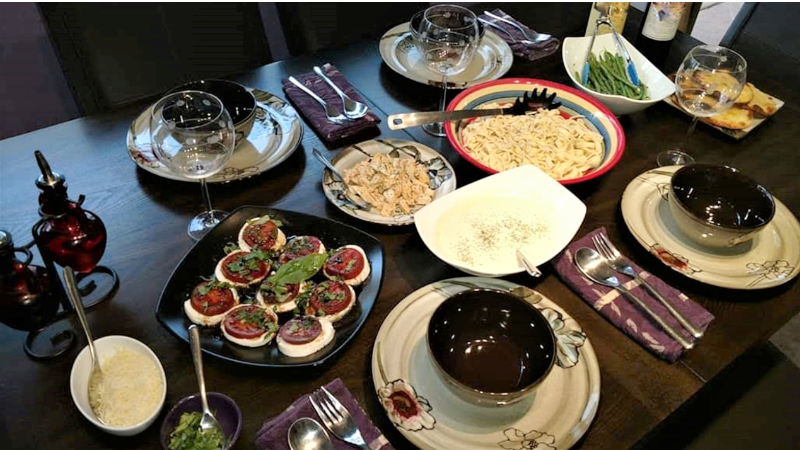With each new month, most of us scan the calendar and wonder – what holidays are coming up and whose birthday is this month? As we head into March, you might be asking… What is St. Joseph’s Day?
In the tradition of Western Christianity, St. Joseph’s Day is the feast day of Saint Joseph, husband of Mary, and the legal father of Jesus.
Also called the Feast of Saint Joseph or the Solemnity of Saint Joseph, the feast day is celebrated every year on March 19th.
In some countries like Italy, St. Joseph’s Day is also recognized as Father’s Day. Although, here in the United States, Father’s Day is not celebrated until mid-June.
Sicilian Origins
A long-held legend in Sicily recounts a devastating drought and impending famine that plagued the villagers and townspeople during the Middle Ages.
They prayed to St. Joseph to bring them rain. If he was able to intercede on their behalf and answer their prayers, they promised to prepare a large feast every year in his honor.
The rains came – the draught ended and wide-spread famine was averted. The Sicilians, as promised, prepared a great banquet in St. Joseph’s honor.
Each year they continue the celebration in thanks for St. Joseph’s intercession and as a symbol of their lasting devotion to their patron saint.
When is St. Joseph’s Day Celebrated?
March 19th was first established as the feast Day of St. Joseph in the 10th Century.
Some people contend that March 19th was chosen in honor of St. Joseph’s death. While others assert St. Joseph did not die until July 20th. Many historians agree that there is little evidence, beyond oral tradition, to support either date. So, the specific reason March 19th was chosen is not altogether known.
St. Josephs’ Day celebrations did not become customary, however, until it was first recognized by the Roman Catholic Church in 1479. The feast day of St. Joseph was further solidified when a papal bull was issued by Pope Pius V on July 14, 1570.
Pope Pius V sought to promote adherence to the Roman Missal, the collection of liturgical books that dictated the words recited and actions taken in celebration of Catholic liturgy. This included the liturgical calendar which denotes important days like saint’s feast days and other days of holy obligation.
St. Joseph’s Day celebrations on March 19th always occur during the Lentin season. This is a time typically marked by fasting and abstaining from meat. However, St. Joseph’s Day has the distinction of being a solemnity.
A solemnity is a feast day that is reserved for the highest-ranking church figures and saints like Jesus, his mother Mary, and you guessed it – Joseph. Based on the Code of Canon Law issued in 1983, meat restrictions are excused on solemnities.
So, even though St. Joseph’s Day falls within Lent, you can now (post 1983) celebrate with your favorite meat dishes. Previously, most St. Joseph’s Day celebrations only included meatless options.
Many traditional St. Joseph’s Day celebrations still reflect this long-held observance.

What is St. Joseph’s Day? Explore a Rich History of Traditions Here and Abroad
As with most holidays and celebrations, there are certain practices, foods, wines, and desserts that are associated with St. Joseph’s Day.
What would Christmas be without fruitcake, Easter without chocolate bunnies or St. Patrick’s Day without a touch of green? St. Joseph’s Day is no different.
Below are a few of the traditions, practices, and foods that make St. Joseph’s Day celebrations extra special and unique.
The St. Joseph’s Day Altar
One ritual which started in Sicily and was brought to America by Italian immigrants in the late nineteenth and early twentieth century is the St. Joseph’s Day altar known in Italy as “la tavola di San Giuseppe.”
The altar, usually set up and prepared the night before on March 18th, is typically an elaborately decorated table with figurines, candles, flowers, and food. The altar can include wine, bread, fava beans as well as cakes, cookies and Zeppoles. St. Joseph’s statue usually has a place of honor at the head of the table.
The items placed on the altar are shared with family, friends, and honored guests during the festivities. There is a long-standing tradition of sharing the fruits of the St. Joseph’s Day altar with the poor or hungry strangers who could not afford their own altars. Etiquette dictated that no one could be turned away from a St. Joseph’s Day altar.
Why do we wear red on St. Joseph’s day?
Red clothing is often worn during family celebrations and at many parades and processions held in St. Joseph’s honor. Although brown and green are the colors in which St. Joseph is most often depicted, red has become the defining color for those celebrating him.
While red has many connotations within the Christian tradition, it represents good luck on St. Joseph’s Day. So be sure to add a touch of red to your outfit on March 19th.
Foods to Include in Your St. Joseph’s Day Celebrations
Generally speaking, St. Joseph’s Day celebrations can include fava beans, one of the only crops that withstood the Sicilian drought mentioned above; breadcrumbs to represent sawdust, a nod to Joseph’s work as a carpenter; and various breads and pastas. In addition to wearing red, items like fava beans and lemons are also said to bring luck to celebrants.
Below is a list of traditional Italian-American St. Joseph’s Day foods as recounted by the owners of Di Camillo Bakery, founded by Tomaso and Addolorata Di Camillo in 1920 in Niagara Falls, New York.
- Anchovies
- Sardines
- Foccacia
- Eggplant Caponata
- Pasta con Sarde
- Egg frittas
- Bean dishes
- Olives
- Fried smelts
- Lentils
- Dandelions and cardones

Zeppoles Are the Official St. Joseph’s Day Dessert
Fruits, cookies, and an array of pastries might be served for dessert, but Zeppoles are the real star of St. Joseph’s Day celebrations. Also known as Zeppole di San Giuseppe, these Italian doughnuts, or fritters, consist of a deep-fried dough ball usually topped with powdered sugar. They also can be cut in the middle and filled with custards, jelly, or a cannoli-type pastry cream.
The Zeppoles served at St. Joseph’s Day harken back to an earlier time during the Roman era and its Liberalia festival – coinciding with winter’s end. Celebrated on March 17th – only two days earlier than St. Joseph’s Day – the Liberalia was a time to honor the gods, Bacchus, and Silenus, who were known as the wine and wheat deities.
The Roman revelers drank wine to honor Bacchus and cooked wheat pancakes to celebrate Silenus. The wheat fritters were cooked in boiling hot lard and were decorated with sugar or cinnamon. Sound familiar? These wheat pancakes would eventually become what we know today as Zeppoles.
Order Your Zeppoles Today in Time for St. Joseph’s Day!
Hopefully, you can now answer the question… What is St. Joseph’s Day?
We learned a lot about the feast of St. Joseph and why this holiday is an important tradition in Italy and here in America. But, the number one fact we found out about St. Joseph’s Day is… You need a big batch of Zeppoles to celebrate in style!
And that is where Boardwalk Zeppoles, a New Jersey-based and family-owned company, comes in. Boardwalk Zeppoles is now bringing Zeppoles, the traditional Italian dessert, right to your doorstep. You can go from freezer to oven to table in a mere 12 minutes.
Owner, Maria Pacillo, perfected her traditional Italian recipe to capture the full Zeppole experience. With one bite you will be transported to a state fair or the New Jersey boardwalk with the piping hot crunchy taste of our authentic Zeppoles.
You can enjoy your Boardwalk Zeppoles the traditional way with powdered sugar or dunk them in one of the savory dips we discuss on our website like our Bacon Corn Dip with Cream Cheese or the must-try Melted Queso Dip with Crumbled Bacon. Yum!
Zeppoles will be a hit at all your family celebrations, game day gatherings and especially at your next St. Joseph’s Day Celebration.
CLICK HERE to order your Boardwalk Zeppoles today!




